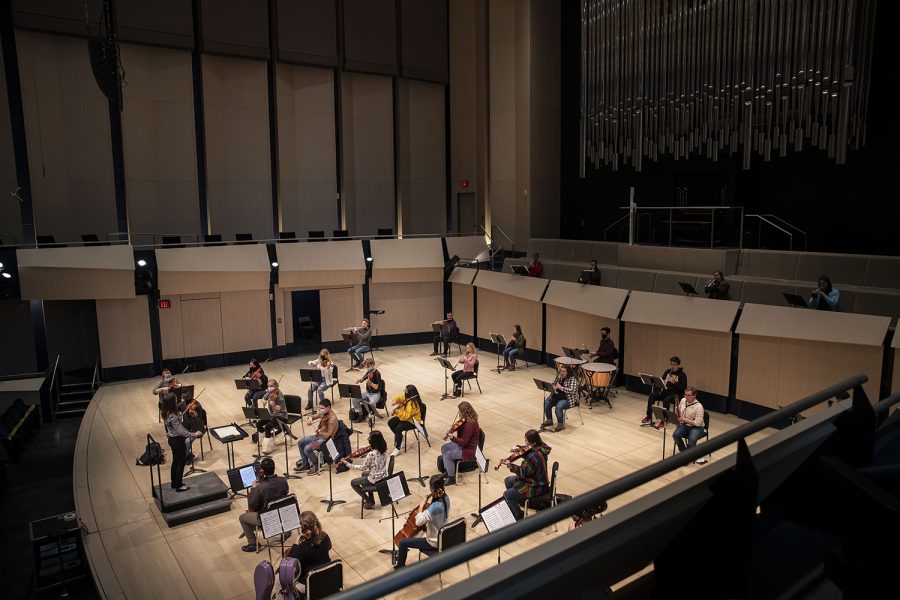UI School of Music addresses lack of diversity in classical music, steps to improve
The University of Iowa School of Music and its orchestra ensembles are taking steps to improve diversity within their ranks. Statistics show that America’s orchestras and the UI School of Music remain overwhelmingly white.
The University Orchestra, conducted by Megan Maddaleno, rehearses in the Voxman music building on Feb. 15, 2021.
February 22, 2021
Classical music in America has been historically and predominantly white. Orchestras large and small have followed the traditional canon of white European male composers since its inception hundreds of years ago.
At the University of Iowa, which offers students the opportunity to join three different orchestras, the orchestral ensembles have improved diversity in the repertoire performed by students, but the School of Music has still struggled with diversifying the student population as a whole.
The UI fields three orchestras, the All-University String Orchestra, The UI Symphony Orchestra, and the UI Chamber Orchestra. The Symphony and Chamber Orchestras require an audition for entry, but the All-University String Orchestra is open to anyone who wishes to enroll in the course.
None of the orchestras require that their members be music majors, but the Symphony and Chamber orchestras are primarily composed of students from the School of Music.
The All-University String Orchestra has 30 musicians, the UI Symphony Orchestra has 59, and the UI Chamber Orchestra has 19.
William LaRue Jones, a UI professor of music and director of orchestral studies since 1997, said orchestra ensembles have made diversity among repertoire a priority this semester.
For Jones, promoting diversity within orchestras begins with the music that is played. He said the importance of diversifying repertoire lies not only in bringing esteem to underrepresented composers, but also in exposing conductors and musicians who play these pieces of music to new ideas they don’t have previous experience with.
“Too often repertoire is all based on European men,” Jones said. “In order to broaden future conductors’ minds and provide the orchestra with the opportunities to play different kinds of repertoire, good repertoire, we include music that was written by minority groups.”
Doctoral conducting student and teaching assistant Fernanda Lastra noted that Jones deliberately seeks out new or underplayed pieces for the orchestras to support diverse composers.
“If you look at all the repertoire that Dr. Jones has done in the last 10 years, you will always see repertoire that is not often performed,” Lastra said. “He is always trying to bring new composers to life.”
Doctoral conducting student and teaching assistant Megan Maddaleno said she views this embrace of new repertoire as the catalyst necessary for lasting change in orchestral ensembles, and the music industry as a whole.
“This revival of bringing in all voices is going to result in a musical renaissance,” Maddaleno said. “I think we are finding out that there is a lot of untapped repertoire that hasn’t yet been discovered that deserves to have some light shown on it. I think this is going to change the way that we think about music.”
Diversifying repertoire is just one way to increase diversity within the field of classical music. Another aspect to consider is whether musicians within the ensembles come from diverse backgrounds. A 2016 study conducted by the League of American Orchestras found that the number of African American, Hispanic/Latinx, and other non-white groups in orchestras remain very low.
Between the years 2002 and 2014, the Hispanic/Latino musician population increased marginally from 1.8 percent to 2.5 percent and the African American population remained stagnant around 1.8 percent. The shifts in diversity that have been noticed in orchestras across the country are driven by Asian/Pacific Islander musicians, which have increased from 5.3 percent to 9 percent over the 12-year period.
These statistics are consistent with how Jones and Ramel Price, a doctoral student in the symphony orchestra, view diversity within UI orchestra ensembles. Both said that there is a level of diversity in the ensemble, but that African Americans are underrepresented.
“Ever since I’ve been here, we’ve had a large number of students coming from South America and Asian countries,” Jones said. “In the School of Music, we’ve always had a certain amount of diversity. The smallest number of any minority group are the Afro-Americans, of which we have very few in the School of Music.”
Price echoed Jones’ statement of the underrepresentation of African Americans in the orchestra ensembles. Price himself is the only Black member of the orchestra.
“Most of the international students that we have are of Asian descent,” Price said. “There are also some students from Latin America. I am the only Black person in the orchestra, I am the only one with that ethnicity, but that is a pretty common thing as a violinist. That is what I’m used to seeing.”
Rachel Li, an undergraduate member of the symphony orchestra, said that a lot of the diversity within the orchestra comes from the graduate program.
“In a sense, it feels diverse, yet again you have to consider that Iowa is a very predominantly white school, so obviously there are going to be more white members than people of color,” Li said. “Most of the diversity comes from the graduate program international students.”
According to the UI 2021 spring student enrollment profile from the UI Office of the Registrar, 54 of the 165 graduate-level students studying music are international students. On the undergraduate level, non-white and international students only account for 1.8 percent of students studying music, music interest, and music education combined.
Simón Zerpa, a doctoral conducting student and teaching assistant, said the School of Music still works to create an inclusive environment.
“I’ve found the University of Iowa, the School of Music in particular, being very caring about diversity,” Zerpa said. “I always felt very welcomed to the school and the orchestra.”
Li noted that the environment in the symphony orchestra isn’t abrasive, but rather one that positively pushes musicians to be better.
“They are very welcoming, and it is a very encouraging environment. It isn’t very cutthroat,” Li said. “There isn’t so much a sense of competition.”
Within the orchestra program and the School of Music, there are scholarships for underserved populations. The School of Music website states that talent scholarships from the School of Music are considered based on a student’s audition.
The school is also taking steps to diversify its faculty. Within the last one-and-a-half years, School of Music Director Tammie Walker said she has hired one woman and two BIPOC men. There are currently five searches underway, one to specifically hire a faculty member from an underrepresented group, and all with emphasis on a commitment to diversity, equity, and inclusion.
Jones said the School of Music has been working on a statement called Diversity, Equity, Inclusion, and Belonging since the beginning of the fall 2020 semester as a response to the Black Lives Matter Movement and other events from the summer.
The UI School of Music diversity trends are similar to the ones found in the study from the American League of Orchestras. Li said she believes the orchestra ensembles are doing what they can to shed light on the issue of diversity in classical music.
“The orchestra program is trying. We are playing a lot more female composers and minority composers to bring exposure to them,” Li said. “That’s one way we are trying to improve on this matter of diversity. I do believe the program has been doing such things to bring light to these artists way before everything like BLM happened.”
















